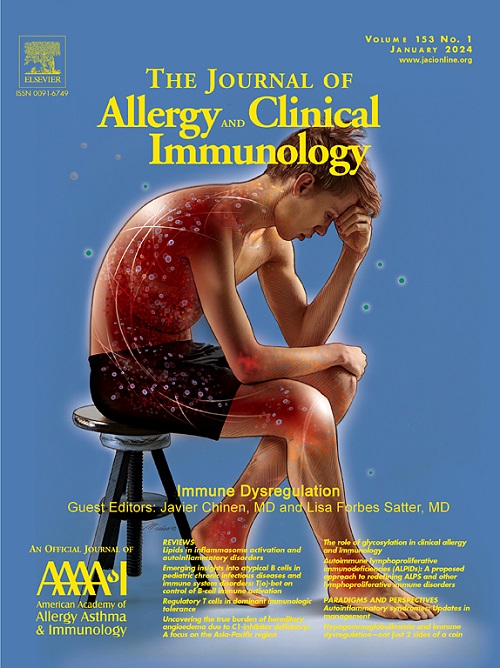慢性阻塞性肺病患者循环中性粒细胞先天免疫重编程。
IF 11.4
1区 医学
Q1 ALLERGY
引用次数: 0
摘要
背景:慢性阻塞性肺疾病(COPD)包括局部和全身性中性粒细胞炎症,伴血液中性粒细胞数量、频率和功能失调。目的研究慢性阻塞性肺病患者循环中性粒细胞的转录和表观遗传学特征,并探讨其与中性粒细胞功能障碍和临床疾病参数的相关性。方法采用染色质免疫沉淀与测序(ChIP-seq)技术对COPD患者和对照供者的循环中性粒细胞进行rna测序(RNA-seq)和组蛋白3赖氨酸4三甲基化(H3K4me3)全基因组分析。通过细胞荧光分析、O2释放和白色念珠菌吞噬试验评估中性粒细胞的活化。结果H3K4me3的rna -seq和ChIP-seq分析显示,参与先天免疫激活的基因处于一种平衡状态,类似于在bcg接种个体的中性粒细胞(称为“训练”)中观察到的表型,其特征是在静息条件下弱表达或不表达,但在刺激时准备高水平表达。在bcg接种者的中性粒细胞中发现的表观遗传特征在COPD中性粒细胞中富集。特别是,与“训练”中性粒细胞所描述的一致,COPD中性粒细胞表现出代谢相关基因的转录重编程。在功能上,COPD中性粒细胞在体外刺激下产生更高的CXCL8和IL-1β水平,释放更多的O2-,并表现出更强的吞噬活性。结论:这些发现表明,COPD中性粒细胞经历了表观遗传、转录组学和代谢重编程,从而增强了它们的反应性,并与之前确定为“训练”的中性粒细胞表型一致,从而为COPD中观察到的功能失调提供了机制见解。本文章由计算机程序翻译,如有差异,请以英文原文为准。
Innate immune reprogramming in circulating neutrophils of COPD patients.
BACKGROUND
Chronic obstructive pulmonary disease (COPD) involves both local and systemic neutrophilic inflammation, with dysregulation in blood neutrophil numbers, frequencies, and functions.
OBJECTIVE
To characterize the transcriptional and epigenetic profiles of circulating neutrophils in COPD patients and explore correlations with neutrophil dysfunction and clinical disease parameters.
METHODS
Circulating neutrophils of COPD patients and control donors were subjected to RNA-sequencing (RNA-seq) and genome-wide analysis of histone 3 lysine 4 trimethylation (H3K4me3) by Chromatin Immunoprecipitation coupled with sequencing (ChIP-seq). Neutrophils' activation was assessed by cytofluorimetric analysis, O2- release and C. albicans phagocytosis assays.
RESULTS
RNA-seq and ChIP-seq analysis of H3K4me3 revealed a poised state in genes involved in innate immune activation, resembling the phenotype observed in neutrophils from BCG-vaccinated individuals, referred to as "trained", that is marked by weak or no expression under resting conditions but ready to be expressed at higher levels upon stimulation. The epigenetic signature identified in neutrophils from BCG-vaccinated subjects was enriched in COPD neutrophils. In particular, and consistent with what has been described in "trained" neutrophils, COPD neutrophils exhibited transcriptional reprogramming of metabolically relevant genes. Functionally, COPD neutrophils produced higher CXCL8 and IL-1β levels, released more O2-, and displayed greater phagocytic activity upon in vitro stimulation.
CONCLUSION
These findings suggest that COPD neutrophils undergo epigenetic, transcriptomic, and metabolic reprogramming, which enhances their responsiveness and aligns with the phenotype of neutrophils previously identified as "trained", offering mechanistic insight into the functional dysregulation observed in COPD.
求助全文
通过发布文献求助,成功后即可免费获取论文全文。
去求助
来源期刊
CiteScore
25.90
自引率
7.70%
发文量
1302
审稿时长
38 days
期刊介绍:
The Journal of Allergy and Clinical Immunology is a prestigious publication that features groundbreaking research in the fields of Allergy, Asthma, and Immunology. This influential journal publishes high-impact research papers that explore various topics, including asthma, food allergy, allergic rhinitis, atopic dermatitis, primary immune deficiencies, occupational and environmental allergy, and other allergic and immunologic diseases. The articles not only report on clinical trials and mechanistic studies but also provide insights into novel therapies, underlying mechanisms, and important discoveries that contribute to our understanding of these diseases. By sharing this valuable information, the journal aims to enhance the diagnosis and management of patients in the future.

 求助内容:
求助内容: 应助结果提醒方式:
应助结果提醒方式:


